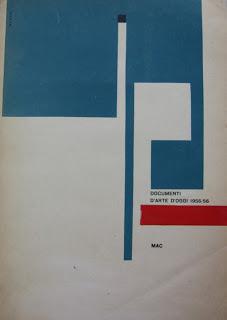
 Poster for the 1954-1955 Gruppo Espace exhibition in Milan,and the verso with woodcuts by Enrico Bordoni (1904-1969)and Silvano Bozzolini (1911-1998)
Poster for the 1954-1955 Gruppo Espace exhibition in Milan,and the verso with woodcuts by Enrico Bordoni (1904-1969)and Silvano Bozzolini (1911-1998)MAC was formed in 1948 by four Italian artists: Atanasio Soldati, Gillo Dorfles, Bruno Munari, and Gianni Monnet. It disbanded in 1958, following the premature death of Gianni Monnet at the age of 46. Besides collective exhibitions, the members of MAC produced four remarkable collections of art and writing entitled Documenti d'arte d'oggi. These publications, which were packed with original lithographs, silkscreens, and woodcuts, came out in 1954, 1955-56, 1956-57, and 1958; I have copies of the second, third, and fourth, but not that for 1954. Now extremely rare, they must have been produced in very small editions, because there is so much handwork in the production, with everything printed on different kinds and weights of paper, and all kinds of collaged elements added. Gianni Monnet in particular was very interested in adding texture by sticking on bits of sandpaper and the like. One of his lithographs has, in addition to various hand-punched holes, a piece of scrumpled newspaper collaged on the surface, and impressions on the surface caused by small oblongs of sandpaper and corrugated board fixed to the facing page.
 Gianni Monnet (1912-1958)Original lithograph with hand-punched holes and collaged newspaper, 1956photographed against a white background
Gianni Monnet (1912-1958)Original lithograph with hand-punched holes and collaged newspaper, 1956photographed against a white background The same Gianni Monnet lithographphotographed as a double-page spread, with color showing through the holes from the image behind
The same Gianni Monnet lithographphotographed as a double-page spread, with color showing through the holes from the image behind Rectangles of corrugated card and sandpaper on the facing page
Rectangles of corrugated card and sandpaper on the facing pageA list of members of Gruppo MAC/Espace in the 1956-1957 volume lists 74 names and addresses. At that time there was a governing committee of six: Gillo Dorfles, Gianni Monnet (Secretary), Bruno Munari, Enrico Prampolini, Mauro Reggiani (President), and Vittoriano Viganó. The majority are listed as painters or sculptors, but there are also plenty of architects and engineers. Several members of MAC achieved fame as industrial and interior designers, including Joe Colombo (Cesare Colombo, 1930-1971), whose Total Furnishing Unit, unveiled at the Museum of Modern Art in New York the year after his death, was a complete "living-machine" comprising kitchen, wardrobe, bathroom and bedroom on just 28 square metres. All the listed members are Italian, but the same page also gives the committee members for Espace in France, Belgium, Switzerland, Sweden, and England. The English group included the architect Wells Coates and the painter Victor Pasmore; the French, André Bloc, Sonia Delaunay, and Edgard Pillet; the Swiss, Alfred Roth, Max Bill, and Richard Paul Lohse; the Swedish, Eric Olson and Olle Baertling. So there was certainly an international dimension to this Italian art movement, which even had a toehold in the USA through the Wittenborn Gallery, which represented MAC artists such as Gillo Dorfles; George Wittenborn also gave limited American distribution to Documenti d'arte d'oggi.
 Bruno Munari (1907-1998)Lithograph cover for Documenti d'arte d'oggi, 1955-1956I believe the collaged strip of shiny red was an "intervention"by Gianni Monnet, but can't now trace the source of this information
Bruno Munari (1907-1998)Lithograph cover for Documenti d'arte d'oggi, 1955-1956I believe the collaged strip of shiny red was an "intervention"by Gianni Monnet, but can't now trace the source of this information Luigi Veronesi (1908-1998)Lithograph cover for Documenti d'arte d'oggi, 1956-1957
Luigi Veronesi (1908-1998)Lithograph cover for Documenti d'arte d'oggi, 1956-1957 Gianni MonnetLithograph cover for Documenti d'arte d'oggi, 1958with die-cut circular hole and collaged corrugated board
Gianni MonnetLithograph cover for Documenti d'arte d'oggi, 1958with die-cut circular hole and collaged corrugated boardDespite this international penetration, it has to be said that the MAC artists have rather fallen into neglect, certainly compared to the 1960s movement that followed, Arte Povera. Perhaps there wasn't a single star artist, whose light could reflect on the others. Perhaps the artist's concerns were too abstracted and intellectualised for popular appeal. Perhaps there just wasn't enough that was truly radical and new in the art they created. Or perhaps they have simply been victims of the fickleness of an art market that prefers a few big names to a lot of small ones, and a simple story arc to a fragmented narrative. I certainly think the death of Monnet and consequent disbandment of MAC stopped the movement in its tracks. Momentum was lost, and some of the major figures, such as Gillo Dorfles, turned their interests elsewhere. Although Dorfles carried on creating art, he put most of his energy into teaching and writing about art and aesthetics.
 Tito B. Varisco, 1915-1998Drawing (reproduced as a conventional line block, I think), slotted through a die-cut television screen;the background drawing can be pulled up and down to reveal different sections on the screen.This comment on the ways in which television would affect our visual perceptionsis a good example of the weird and wonderful stuff to be found in Documenti d'arte d'oggi.It comes from the volume for 1955/56.
Tito B. Varisco, 1915-1998Drawing (reproduced as a conventional line block, I think), slotted through a die-cut television screen;the background drawing can be pulled up and down to reveal different sections on the screen.This comment on the ways in which television would affect our visual perceptionsis a good example of the weird and wonderful stuff to be found in Documenti d'arte d'oggi.It comes from the volume for 1955/56.More to come on individual MAC artists.

